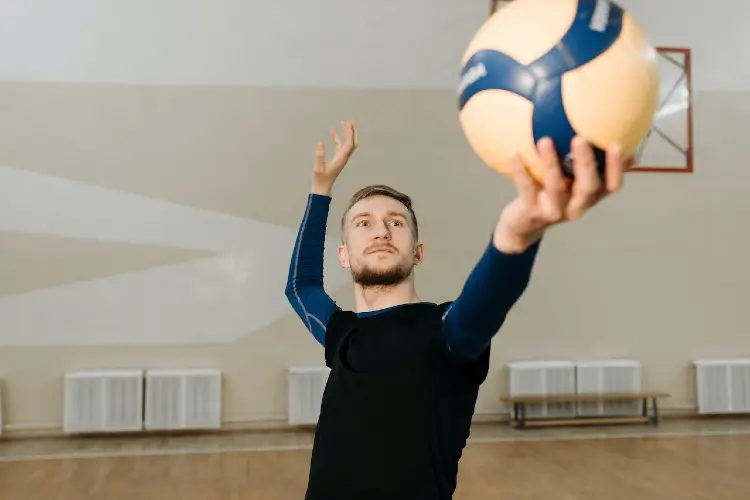Last Updated: October 19, 2023
Serving in volleyball to many is simply hitting the ball across the net, but this is not usually the case. A ball that crosses the net and fails to fall within the set boundaries isn’t playable. A well-executed serve builds your team’s morale and can be a weapon for winning the match.
While there are different types of serves, you must incorporate two or more when playing. The aim is to leave your opponents in the dark about your next move. This can earn your team a score when the other team fails to return your serve.
But then, how to perfect your volleyball serve to play like a pro? Use the below 15-point checklist.
Tips for Perfecting Your Volleyball Serve

Implementing these skills to the letter will be helpful to you as an individual player and the team at large.
1. Get a Balanced Stance
It’s difficult to perform the right serve when you haven’t placed your body in a balanced posture.
Doing this is simple – place your non-dominant foot forward and ensure it’s 4 to 5 inches ahead of the dominant foot.
Before the game, you should have practiced getting a correct stance, which shouldn’t be a problem. If you don’t get a stable stance, it might prove problematic to make the right serve, thus giving room for an error.
Additionally, put your head in a neutral position and bend the knees slightly forward from your waist. Position both arms above the head but fully extended.
Hold the ball with the non-dominant hand, and the dominant hand should be set to hit the ball. This results in a downward motion that’s great for you to hit the ball with more force.
2. Position Your Feet Correctly
Your left foot should point where you plan to serve the ball. However, getting the right footwork isn’t easy and can be achieved with more exercise. The posture of your body should correspond to the upper part, hips, and feet.
For example, point your upper body, left foot, and hips ahead if you are serving down the line or point them cross-court if that’s your target area.
3. Balance Your Body Weight
As you prepare to make a serve, ensure you feel your body weight on your back foot. Next, quickly adjust the body weight to your front foot after tossing the ball.
The instant shifting of the body weight forward combines with arm swing when hitting the ball to give more torque to pass the net easily.
4. Raise Your Elbows
Raise your elbows to a few inches above your ear before drawing or pulling the arm back to hit the ball. This activity gives you a higher chance of hitting the ball with more velocity to fly past the 9-foot net.
You can exercise this until you are perfect to prevent making the mistake of the ball hitting the net.
5. Build Your Confidence
You must have confidence before performing the serve since it’s just you and the ball, and all eyes are on you. This can be hard if you are a beginner participating in a tournament. But don’t worry; by now, you have done enough exercise and are sure of what you are doing.
What if you are the kind of person who gets tensed up quickly?
This should not discourage you, as you can develop a serving strategy. Even something like saying some words before serving the ball, such as: “I can do it, or yes I can” can greatly help.
6. Face Your Target
Facing your target is a technique you should implement if you are a beginner. This is because facing one point and serving to another can put you off-balance.
But you can do this effortlessly if you are an experienced player. This method takes the opponents off guard and disrupts the serve receive, which can be an advantage to your team.
7. Pick the Right Serve
There are various volleyball serving techniques. Which one you use depends on your experience. The harder it is to master the serve (such as the jump serve), the more effective it usually is.
Underhand Serve
An underhand serve is the easiest to perform, thus great for beginners. You should follow through with your arm swing to avoid making mistakes when you hit the ball.
You can perfect an underhand serve by practicing the target drill, which requires serving toward a particular target.
Overhand Serve
Unlike the underhand serve, the overhand serve requires you to toss the ball into the air before hitting it. Therefore, you should know how to perform a good toss to get a reliable overhand serve. Above all, toss the ball to a height you are comfortable hitting. Follow through the serve with your body to give the ball more momentum.
However, don’t hit the ball too soft or hard; just hit it correctly. Hitting too hard can make the ball lose direction or go out of given boundaries. Similarly, hitting too soft will make the ball go over the net slowly and make it easy for the opponents to defend, thus, a weak serve.
Jump Serve
This service is usually performed by players who are experienced. A beginner should start from the underhand serve and slowly advance to the overhand and jump serves.
Master combining speed, accuracy, and power to execute a jump serve. Nonetheless, practice steady ball tossing, timing, and safe landing for total body control after the jump.
8. Move Forward
Position your body, hips, shoulders, and front foot straight to your target area and toss the ball in the same direction as your body. This allows you to form more velocity and force to hit the ball since all your energy is focused in one direction as you also move forward.
However, achieving the highly-needed momentum to hit the ball can reduce if your feet, shoulders, and hip point in a similar direction.
9. Make the Right Toss
A toss lets you position the ball correctly before hitting it. Practicing a good toss is vital for making a fruitful overhand serve. But if your toss isn’t good, your capability to make the right serve becomes hard and random.
Practice tossing as much as possible until you can perform it naturally without straining for an extra success rate.
10. Make the Right Ball Contact
An open palm is ideal for serving a ball since you will have bigger area of contact. Using a closed fist isn’t the best way to serve a ball as you will be prone to injury.
Contact the ball when the toss is at its highest point or at a comfortable height so you can extend your dominant hand. Follow through with your arm and the rest of the body when contacting the ball for added velocity.
11. Own Your Serve
You should “Own your serve” since you serve the ball. It’s not about your teammates, but it’s up to you to make it right or wrong. Have confidence in what you have learned and exercised, believing you will deliver a successful service.
Here are some pointers to help you own your serve:
- Having a workable pre-serve routine
- Know when you should be aggressive depending on your opponent’s strengths and weaknesses
- Know when you should just let the ball in
- Develop a consistent but good toss through practice
12. Get a Consistent Toss
Consistency is key when making a toss. Many errors in serving are made because the server fails to toss the ball to the same height as the previous one. This forces the player to adjust how high the dominant arm will go before hitting the ball. This changes how the hand will contact the ball and the resultant ball flight.
13. Learn From Legends
If you are an amateur player, learning how to serve from your teammates or coach is best. But this should not be the end of the road when you have mastered the serving skillset. Keep learning by emulating legendary volleyball players you usually see on TV to up your serving, and very soon, you will be serving like a pro.
14. Avoid a Penalty
Avoid getting a penalty when serving, especially when rally scoring is used. If your team performs any service errors, its serve will be lost, and your opponents will get a point.
Here are examples of some service errors:
 The ball hits the net and bounces back
The ball hits the net and bounces back The ball lands out-of-bounds
The ball lands out-of-bounds The ball hits your fellow teammate before reaching the opponent’s side
The ball hits your fellow teammate before reaching the opponent’s side When you serve out of order
When you serve out of order
15. Repetition
You shouldn’t be in a hurry when you want to learn to serve and perfect the skill. Practice proper footwork, body positioning, tossing the ball, and making the final hit many times over. This helps to gain more confidence, consistency, and accuracy when making a serve.
Conclusion
Though volleyball includes other skills like setting, spiking, blocking, digging, or passing, serving is the single one technique that allows the player total control. So, practicing a serve is essential for your team’s success. The above 15-point checklist will help you to perfect your volleyball serve.
Since every player in a team is mandated to serve, your focus should be getting a good and playable serve. Poor serves can lower your team’s self-esteem and make it lose valuable points.
Use your body, feet, hips, shoulders, and hands, to maximize your chances of making a perfect serve. This can only be achieved through proper practice, resiliency, and determination.
